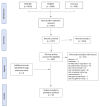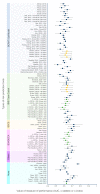A Systematic Review and Critical Assessment of Breast Cancer Risk Prediction Tools Incorporating a Polygenic Risk Score for the General Population
- PMID: 38001640
- PMCID: PMC10670420
- DOI: 10.3390/cancers15225380
A Systematic Review and Critical Assessment of Breast Cancer Risk Prediction Tools Incorporating a Polygenic Risk Score for the General Population
Abstract
Single nucleotide polymorphisms (SNPs) in the form of a polygenic risk score (PRS) have emerged as a promising factor that could improve the predictive performance of breast cancer (BC) risk prediction tools. This study aims to appraise and critically assess the current evidence on these tools. Studies were identified using Medline, EMBASE and the Cochrane Library up to November 2022 and were included if they described the development and/ or validation of a BC risk prediction model using a PRS for women of the general population and if they reported a measure of predictive performance. We identified 37 articles, of which 29 combined genetic and non-genetic risk factors using seven different risk prediction tools. Most models (55.0%) were developed on populations from European ancestry and performed better than those developed on populations from other ancestry groups. Regardless of the number of SNPs in each PRS, models combining a PRS with genetic and non-genetic risk factors generally had better discriminatory accuracy (AUC from 0.52 to 0.77) than those using a PRS alone (AUC from 0.48 to 0.68). The overall risk of bias was considered low in most studies. BC risk prediction tools combining a PRS with genetic and non-genetic risk factors provided better discriminative accuracy than either used alone. Further studies are needed to cross-compare their clinical utility and readiness for implementation in public health practices.
Keywords: breast cancer; non-genetic risk factors; polygenic risk score (PRS); risk prediction tools; systematic review.
Conflict of interest statement
The authors declare no conflict of interest. The funding sponsors had no role in this project.
Figures




Similar articles
-
Discovery of breast cancer risk genes and establishment of a prediction model based on estrogen metabolism regulation.BMC Cancer. 2021 Feb 25;21(1):194. doi: 10.1186/s12885-021-07896-4. BMC Cancer. 2021. PMID: 33632172 Free PMC article.
-
Addition of polygenic risk score to a risk calculator for prediction of breast cancer in US Black women.Breast Cancer Res. 2024 Jan 2;26(1):2. doi: 10.1186/s13058-023-01748-8. Breast Cancer Res. 2024. PMID: 38167144 Free PMC article.
-
Development and Validation of a Breast Cancer Polygenic Risk Score on the Basis of Genetic Ancestry Composition.JCO Precis Oncol. 2022 Nov;6:e2200084. doi: 10.1200/PO.22.00084. JCO Precis Oncol. 2022. PMID: 36331239 Free PMC article.
-
Polygenic risk prediction models for colorectal cancer: a systematic review.BMC Cancer. 2022 Jan 15;22(1):65. doi: 10.1186/s12885-021-09143-2. BMC Cancer. 2022. PMID: 35030997 Free PMC article.
-
Evaluation of polygenic risk score for risk prediction of gastric cancer.World J Gastrointest Oncol. 2023 Feb 15;15(2):276-285. doi: 10.4251/wjgo.v15.i2.276. World J Gastrointest Oncol. 2023. PMID: 36908320 Free PMC article. Review.
Cited by
-
Deriving a Mammogram-Based Risk Score from Screening Digital Breast Tomosynthesis for 5-Year Breast Cancer Risk Prediction.Cancer Prev Res (Phila). 2025 Jun 2;18(6):347-354. doi: 10.1158/1940-6207.CAPR-24-0427. Cancer Prev Res (Phila). 2025. PMID: 40066855 Free PMC article.
-
Breast cancer: The good, the bad, and an important call to effective risk reduction strategies.CA Cancer J Clin. 2024 Nov-Dec;74(6):471-474. doi: 10.3322/caac.21867. Epub 2024 Oct 1. CA Cancer J Clin. 2024. PMID: 39352019 No abstract available.
-
Timely germline BRCA testing after invasive breast cancer promotes contralateral risk-reducing mastectomy and improves survival: an observational retrospective study.Breast Cancer Res Treat. 2025 Jul;212(2):309-323. doi: 10.1007/s10549-025-07726-2. Epub 2025 May 23. Breast Cancer Res Treat. 2025. PMID: 40408052 Free PMC article.
-
Following the High-Risk Patient: Breast Cancer Risk-Based Screening.Ann Surg Oncol. 2024 May;31(5):3154-3159. doi: 10.1245/s10434-024-14957-y. Epub 2024 Feb 1. Ann Surg Oncol. 2024. PMID: 38302622 Review.
-
Structural equation modeling of factors influencing women's attitudes, comfort and willingness toward risk-stratified breast cancer screening.Sci Rep. 2025 Jul 30;15(1):27805. doi: 10.1038/s41598-025-13641-9. Sci Rep. 2025. PMID: 40738960 Free PMC article.
References
-
- WHO Cancer n.d. [(accessed on 26 September 2019)]; Available online: https://www.who.int/news-room/fact-sheets/detail/cancer.
-
- Klarenbach S., Sims-Jones N., Lewin G., Singh H., Thériault G., Tonelli M., Doull M., Courage S., Garcia A.J., Thombs B.D. Recommendations on screening for breast cancer in women aged 40–74 years who are not at increased risk for breast cancer. CMAJ. 2018;190:E1441–E1451. doi: 10.1503/cmaj.180463. - DOI - PMC - PubMed
Publication types
Grants and funding
LinkOut - more resources
Full Text Sources
Medical

